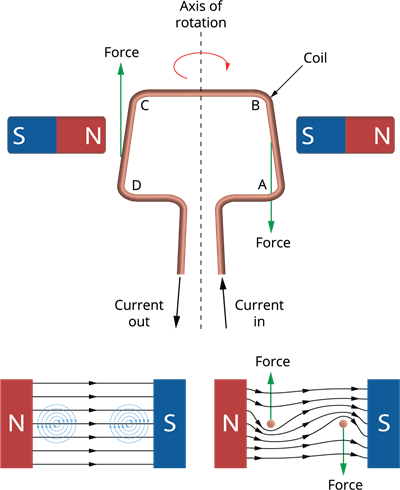
PUMPA - SMART LEARNING
எங்கள் ஆசிரியர்களுடன் 1-ஆன்-1 ஆலோசனை நேரத்தைப் பெறுங்கள். டாப்பர் ஆவதற்கு நாங்கள் பயிற்சி அளிப்போம்
Book Free DemoA device that converts electrical energy into mechanical energy is known as an Electric motor.
We need to understand how a current-carrying coil experiences a turning effect when placed inside a permanent magnetic field to understand how a motor works.

Turning effect of a coil
Construction of electric motor:
A simple coil is inserted between the magnet's two poles. Take a look at segment \(AB\) of the current-carrying conductor. The current is flowing in the direction of \(B\), whereas it is flowing in the opposite direction in the conductor segment \(CD\). Because the current in the segments \(AB\) and \(CD\) is flowing in opposite directions, the segments' motion will be in opposite directions according to Fleming's Left-hand rule. When the coil's two ends are subjected to opposing forces, they rotate.
Working:
If the current flows along the \(ABCD\) line, the coil will rotate clockwise first, then anti-clockwise. If we want the coil to rotate in one direction, say clockwise, the current should flow along \(ABCD\) for the first half of the rotation and \(DCBA\) for the second half. A small device known as a split ring commutator is used to change the direction of the current.
There is no current flow in the coil when the gap in the split ring commutator is aligned with terminals \(X\) and \(Y\). However, as the coil moves forward, one of the split ring commutators comes into contact with the carbon brushes \(X\) and \(Y\). The current reversal is repeated every half rotation, resulting in a continuous rotation of the coil.
The speed of the rotation of the coil can be increased by:
- Intensifying the coil's current
- Expanding the coil's number of turns
- Expanding the coil's surface area
- Amplifying the magnetic field's strength